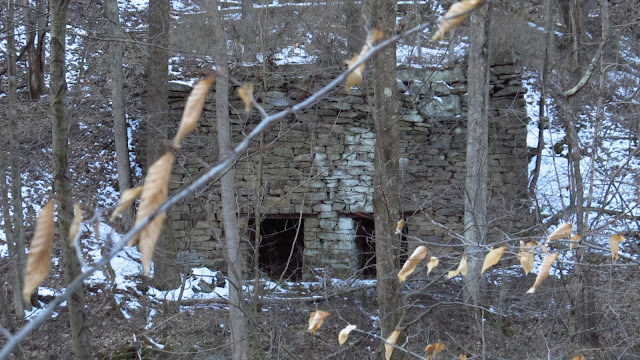These lime kilns were something we noticed the other day. I have driven this road many times in the summer and never noticed them due to the foliage. Lime Kilns are very new to me. From the information I researched, I found out these were called Draw Kilns. I also found that they're rare to find in this condition and almost impossible to date. This style of kiln has been used for thousands of years. They don't appear on old maps like coke ovens or iron furnaces and they weren't really considered a heavy industry. These kilns could be used on an as needed basis and were worked to produce quicklime for agricultural or construction needs. They could also be used on a consecutive basis, being recharged while one charge was being finished.
As far as these particular kilns, there is next to nothing written about them. The 1993 HAER Indiana County Inventory of Historic Engineering and Industrial Sites casually mentions them, stating only that "Old timers in the neighborhood do not remember the kilns in operation, but had heard of their existence". None of the Indiana County history books I have access to mention them. So this leads me to believe that these were used locally by area farmers and masonry workers. It does not appear to be a large scale industrial operation because certainly there would have been some record. The quicklime produced by these kilns may have been the work of a local farmer with access to a coal vein and a small limestone quarry. Now that we know what they are, we probably need to head back out and look for evidence of a mine and quarry. We did find raw coal on the hillside behind the kilns and on top of the kilns themselves.
How these kilns operated was extremely simple but definitely required a skilled worker to do it properly. Fuel (wood or charcoal was used early on but gradually shifted to coal or coke) was laid first, followed by limestone, followed by another layer of fuel, then limestone etc.
 |
Chart showing how Draw Kilns were charged. Photo courtesy of University College London. |
The charge is lit from the bottom where the finished quicklime is also removed from. A charge would bake for around 36 hours or until the worker determined it was ready to draw. When the kiln was ready to draw, the load would sink and another charge of fuel and limestone could be added to the top. I'm sure there was more to it than this, but these are the basics. As I said I'm still learning about lime kilns. What I don't understand is, the kiln was also made of limestone, wouldn't the kiln itself calcify?
Another thing, apparently these are rare to find in this condition. There have been parks built up around them in places like Wisconsin, Washington, California, and the UK. Another gem we have right here in Southwestern Pennsylvania!
 |
This is what we saw from the road. |
 |
The grate is still intact from where the charge was lit and the calcified lime would come through. |
 |
The other side. |
 |
Hand stacked stone. Just amazing. |
 |
This is looking down into where the charge was placed. It's a big pit. |
 |
Both sides. |
 |
Other side of the kiln. |
 |
The front again. The work "holes" were supported by steel rail. The grates were made of rail as well. |


I seen similar ovens on rt 259 b4 mulligan hill rd heading to new Florence. Always wondered what they were for.
ReplyDeleteI live in Vietnam. I am not fluent in English. I use google traslate. I have lime furnace like yours. You need information about lime kilns, email me. My email canhhung.vmmt@gmail.com
ReplyDelete